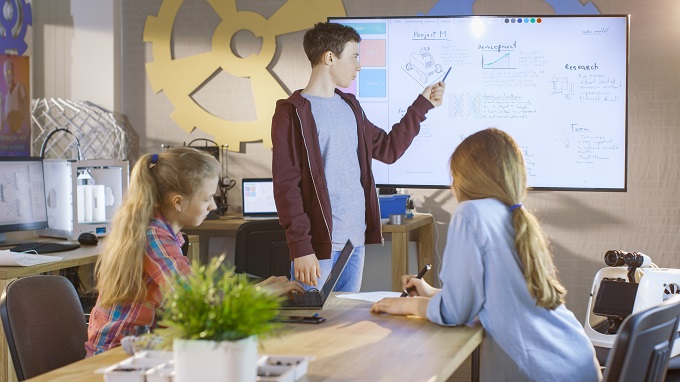
Students can explain the concept aloud as if teaching to another person. Image: AdobeStock by Gorodenkoff
Modern Smart Classrooms, therefore, not only reflect the existing digital knowledge and expectations of 21st century learners, but also the increasingly technology-based world outside the classroom.
In effect, smart classrooms can be seen as the amalgamation of the technology used by the teacher and at the front of the class (e.g., projectors), and the technology used by the students (e.g., laptops), plus the physical environment (e.g., furniture or charging stations) that facilitate the successful use of this technology.
Yet the simple addition of smart boards, digital projectors, laptops, tablets, or any other technological paraphernalia into a traditional classroom does not transform it into a smart classroom. Like the ‘pen and paper’ technology of yesteryear, a modern laptop, say – or any similar device – is simply a tool for learning, one that must be used and supported appropriately.
Smart classrooms are designed to nurture and encourage students’ curiosity and desire to learn not because of the technology involved but via how this technology is effectively employed. And while both successful smart and traditional classrooms are ones where teacher and students interact collaboratively in the physical space of the classroom, with the smart classroom this extends to the virtual space made available via computer technology.
The knock-on effects of the virtual space created by a smart classroom – one in which every student can access a device – includes many positives, including:
Used effectively, smart classrooms can improve students’ academic improvement through engaging them more fully (as well as exposing them to technology used in modern workplaces) while providing both them and the teacher with immediate feedback on their learning progress.
But to be effective, a smart classroom also needs:
While choice of equipment – individual touchscreens and multi-touch displays, say, or group touch tables and teaching stations – are school-wide priorities, so too is appropriate professional development for the schools’ teachers, those who must competently and confidently guide students’ use of the equipment itself.
Teachers need and desire ongoing training with the hardware and software they are expected to use, and in the teaching methodologies they are expected to employ; in other words, an effective smart classroom needs teacher ‘buy-in’.
Of course, expert advice is needed so that schools make the right decisions about how to create or enhance effective smart classrooms, and often numerous product suppliers will be required to give input: hardware specialists (for the physical computers, projectors, etc.), software and program specialists, equipment suppliers (especially those offering rental or leasing options), and so on.
Here, School News focuses on one of the key components of a modern smart classroom, the front-of-class TV or projector that provides an interface between teacher and students. We ask Epson New Zealand’s Business Manager (Visual Solutions), Mike Conza, to explain what factors need to be taken into account when choosing an appropriate smart classroom TV or projector.
With today’s classrooms becoming more technology based, it’s still important to get the basics right when it comes to the size of the classroom’s TV or projector image as this is generally the point of focus of the material being taught to students. In many classrooms, the presented image is either too low so those students not in the front row struggle to see the lower third of the content or the image itself is too small for a good proportion of the students to read clearly.
Research recently conducted in the USA indicated that over half of the students in an average classroom could not fully read content on a 70” flat panel TV. Where image size generally goes wrong is that a decision is made based on a person’s TV viewing experience at home. Where this comes unstuck is that content being viewed at home is video-based – with minimal text to read – or what is considered ‘passive viewing’. In the classroom, by contrast, the bulk of the content presented is text-based, meaning a bigger image is required for all students to see the content clearly.
The much-delayed English draft curriculum is now out for consultation, generating discussion from teachers.
Research from AUT demonstrates arts, culture and recreation have positive impacts on all aspects of…
How effective has the school phone ban been in achieving its aims? Researchers from the…
School camps and excursions deliver hands on learning experiences, helping to consolidate classroom learning.
Innovations in AV technologies present new opportunities to engage with students. We look at how…
A new report from the University of Auckland’s Our Voices Project asks young people what…
This website uses cookies.